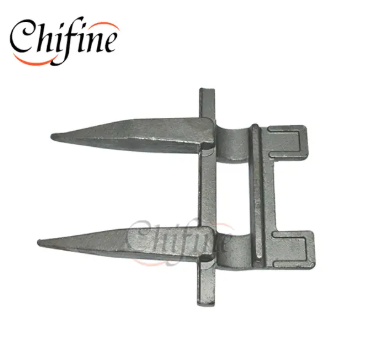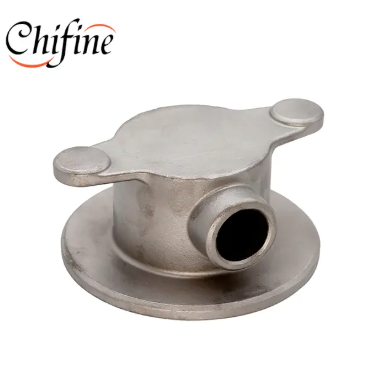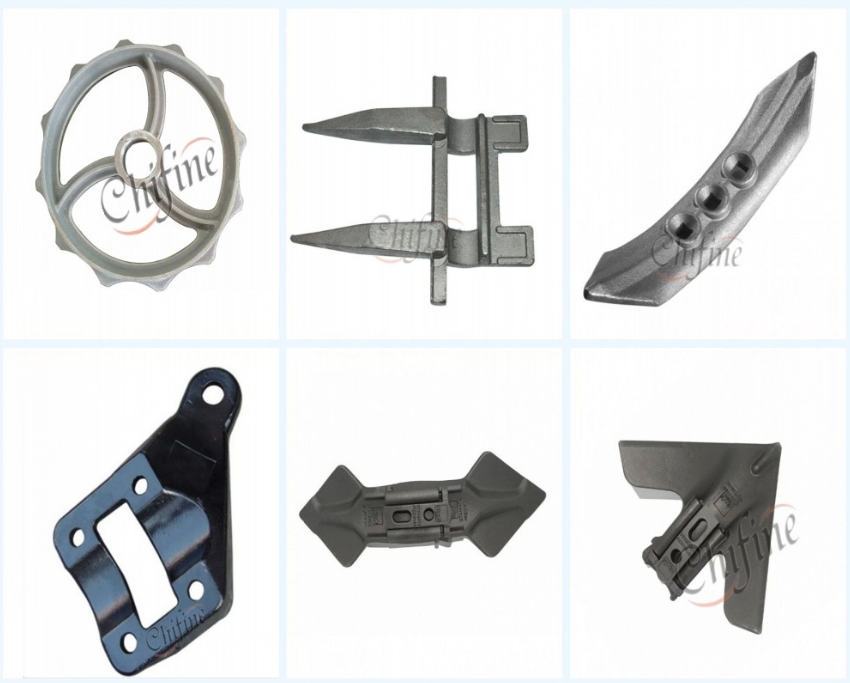+86-15763932413
Views: 0 Author: Site Editor Publish Time: 2025-10-24 Origin: Site








Iron casting is one of the most versatile manufacturing processes, enabling intricate designs and durable components without additional fabrication. Among the many materials suitable for casting, iron and steel are widely used for their strength, toughness, and reliability. While cast iron and cast steel may appear similar, they have distinct differences in composition, mechanical properties, and applications. Knowing how to tell cast iron from steel is essential for engineers, manufacturers, and DIY enthusiasts who work with iron casting components.
Cast iron is an iron-carbon alloy with more than 2% carbon. It often includes silicon, manganese, phosphorus, and sulfur, and alloyed cast irons may contain nickel, chromium, or molybdenum for improved performance.
Types of Cast Iron in Iron Casting:
Grey Iron: Flaky graphite provides excellent vibration damping, compressive strength, and shock absorption. Commonly used in engine blocks, housings, and decorative iron casting.
White Iron: Carbon mainly as cementite; hard and brittle, poor impact resistance.
Malleable Iron: Annealed white iron with clustered graphite; good wear resistance, plasticity, and toughness.
Ductile Iron: Spherical graphite improves strength, toughness, and ductility; ideal for high-strength structural iron casting components like crankshafts and gears.
Vermicular Iron: Worm-shaped graphite; properties between grey and ductile iron.
Alloy Cast Iron: Enhanced with Ni, Cr, Mo, or Cu to provide heat resistance, corrosion resistance, and wear resistance in specialized iron casting applications.

Cast steel is used for high-strength castings requiring toughness and impact resistance. It contains less carbon than cast iron (0.1–0.5%) and may include alloying elements to enhance mechanical properties.
Types of Cast Steel in Iron Casting:
Cast Carbon Steel: Provides strength, ductility, and cost-effective manufacturing.
Low-Alloy Cast Steel: Alloyed with elements like Mn, Cr, and Cu (<5%) for improved toughness and heat-treated performance.
Special Cast Steel: Designed for specific industrial applications, such as high-temperature or high-wear components.

Carbon content is the primary factor in distinguishing cast iron from steel:
Cast iron: >2% carbon → hard, brittle, excellent compressive strength
Cast steel: 0.1–0.5% carbon → tough, ductile, high impact resistance
| Property | Cast Iron | Cast Steel |
|---|---|---|
| Toughness | Low | High |
| Hardness | High | Moderate to High |
| Compressive Strength | High | Moderate |
| Tensile Strength | Low | High |
| Vibration Damping | Excellent | Moderate |
| Brittleness | High | Low |
| Wear Resistance | High | Moderate |
| Impact Resistance | Low | High |
Cast iron: Excellent flowability, low shrinkage, ideal for intricate molds in iron casting. Easy to machine due to graphite acting as a natural lubricant.
Cast steel: Less fluid, more shrinkage, sensitive to mold reactions. Requires precise control and often heat treatment. Machining can be more challenging and tool-intensive.
Cast iron: Forms a protective patina naturally; graphite content improves wear resistance in iron casting components.
Cast steel: Less naturally resistant but alloying (e.g., stainless steel) enhances corrosion resistance while maintaining strength.
Cast iron: Lower material and energy costs make it ideal for large-scale iron casting projects.
Cast steel: Higher production costs, but provides long-term durability and high-impact resistance.
When working with iron casting, it is important to accurately distinguish between cast iron and cast steel, as their properties, machinability, and applications differ significantly. Here are the most effective methods:
Color: Cast steel typically has a brighter, metallic luster, while cast iron appears darker and duller. Among cast irons, ductile iron tends to be slightly brighter than grey iron due to its spherical graphite structure. Observing the surface color can give a quick first clue about the material.
Grains: The microstructure differs significantly. Cast steel is very dense, and its grain structure is usually invisible to the naked eye. In contrast, cast iron grains, especially in grey iron, are often visible as small crystalline patterns. This is a clear indicator during iron casting inspections.
Fracture appearance: Breaking a small test piece can reveal differences in fracture patterns. Grey iron shows a dark grey, granular fracture, while white iron displays a shiny, silvery fracture due to its cementite-rich structure. Ductile iron fractures tend to show spherical graphite nodules within a metallic matrix.
Cast steel: Produces a clear, ringing sound, often described as “Dang Dang,” when tapped with a hammer or metal tool. This is due to its toughness and ductility, which allows vibrations to propagate.
Cast iron: Sounds dull and short when struck, reflecting its brittle nature. Ductile iron produces a longer echo than grey iron, giving a subtle auditory clue about its microstructure.
Bend test: Applying force to a small sample can indicate toughness. Cast steel will bend slightly before deforming permanently, demonstrating high ductility. Grey cast iron, on the other hand, fractures almost immediately due to brittleness. Ductile iron may bend slightly but not as easily as steel.
Gas cutting: In iron casting operations, cast steel can be cut with an oxy-acetylene torch due to its uniform composition. Ductile iron is more challenging to cut with gas torches and often requires specialized cutting tools, whereas grey iron can crack if heat is applied unevenly.
For precise identification, especially in critical iron casting applications, laboratory methods provide definitive results:
Chemical analysis: Determines carbon and alloying element content, confirming whether the material is cast iron (>2% C) or cast steel (<0.5% C).
Metallography: Microscopic examination of the material’s structure can reveal graphite flakes, nodules, or pearlite content, providing a clear distinction between different cast irons and steels.
Non-destructive testing (NDT): Techniques such as ultrasonic testing, radiography, or magnetic particle inspection can detect internal cracks, porosity, and shrinkage defects that may affect performance, without damaging the component.
By combining these methods—visual, auditory, mechanical, and laboratory tests—engineers and technicians can confidently determine the material type and select the appropriate treatment or application in iron casting projects.

Choosing the right material is critical for successful iron casting projects. Both cast iron and cast steel have unique advantages, making them suitable for different applications depending on strength, toughness, wear resistance, and vibration damping requirements.
Engine blocks and cylinder heads: Grey iron’s excellent vibration damping reduces engine noise and stress on moving components.
Gear blanks and machine beds: The compressive strength and wear resistance of cast iron make it ideal for heavy-duty components that must withstand static loads.
Housings, stoves, and enclosures: Cast iron’s thermal stability and resistance to deformation under heat make it suitable for appliances and industrial housings.
Decorative and architectural iron casting: Its ability to flow into intricate molds allows for ornate designs in gates, fences, benches, and other decorative elements. Iron casting with grey iron or ductile iron can achieve complex shapes while maintaining durability.
Pipes and fittings: Some types of cast iron, especially ductile iron, are used in pipelines due to corrosion resistance and strength.
Structural components and heavy-duty mechanical parts: High tensile strength and toughness make cast steel ideal for load-bearing structures in construction and industrial machinery.
Crankshafts, industrial gears, and suspension components: Cast steel can withstand high impact forces and cyclic loads without fracturing, making it preferable for dynamic applications.
Valve bodies, pump casings, and turbine wheels: Steel’s ductility and resistance to impact allow it to perform reliably under pressure, heat, and mechanical stress.
Forging and forming dies: Cast steel can endure repeated mechanical impact and wear, extending service life.
By understanding the strengths of each material, engineers can select the best option for specific iron casting projects, balancing cost, durability, and performance requirements.
Handling cast iron and steel during iron casting operations requires attention to both material properties and safety protocols:
Handle brittle materials with care: Grey iron is hard but brittle. Dropping or mishandling parts can cause fractures or injuries. Always use proper lifting equipment and protective gear.
Use heat treatment for steel castings: Cast steel can develop internal stresses during cooling. Stress-relieving heat treatment reduces the risk of cracking and improves toughness.
Employ correct cutting, welding, and machining techniques:
Grey iron: Best machined with sharp tools to avoid chipping; welding is challenging due to brittleness.
Ductile iron: Can be machined and welded more easily but requires preheating to prevent cracking.
Cast steel: Machining is more demanding but allows for welding and forming with proper heat control.
Inspect castings before use: Check for cracks, porosity, or shrinkage defects using visual inspection or non-destructive testing (NDT) to ensure quality and safety.
Use appropriate protective equipment: Gloves, safety goggles, and steel-toed boots help prevent injuries when handling heavy castings.
The main difference between cast iron and cast steel lies in their carbon content, with cast iron containing more than 2% carbon, making it hard and brittle, while cast steel contains 0.1–0.5% carbon, making it tough, ductile, and impact-resistant.
Cast steel usually appears brighter and metallic, while cast iron is darker and duller; additionally, cast steel has a dense grain structure invisible to the naked eye, whereas cast iron grains, especially in grey iron, are often visible, and the fracture of grey iron appears dark grey, white iron appears silvery-white, and ductile iron shows spherical graphite nodules.
Yes, cast steel produces a clear, ringing “Dang Dang” sound when tapped, while cast iron sounds dull and short, and ductile iron has a slightly longer echo than grey iron.
You can perform a bend test where cast steel bends before deforming while grey cast iron fractures immediately, and gas cutting can also help because cast steel can be cut with a torch, ductile iron is more challenging, and grey iron may crack under uneven heat.
Advanced laboratory methods include chemical analysis to determine carbon and alloying elements, metallography to examine the microstructure, and non-destructive testing (NDT) such as ultrasonic or radiography to detect internal defects without damaging the iron casting.
Understanding the differences between cast iron and cast steel is key to making the right choice in iron casting projects. From carbon content and mechanical performance to castability and wear resistance, knowing how each material behaves ensures stronger, more reliable components for your designs.
For high-quality castings and expert support, Qingdao Chifine Machinery Co., Ltd offers over 20 years of experience in producing durable iron and steel components. Whether for structural parts, machinery, or decorative pieces, their solutions help you achieve precision, strength, and long-lasting performance.
